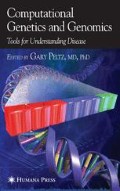Abstract
Commonly available inbred mouse strains can be used to genetically model traits that vary in the human population, including those associated with disease susceptibility. In order to understand how genetic differences regulate trait variation in humans, we must first develop a detailed understanding of how genetic variation in the mouse produces the phenotypic differences among inbred mouse strains. The information obtained from analysis of experimental murine genetic models can direct biological experimentation, clinical research, and human genetic analysis. This “mouse to man” approach will increase our knowledge of the genes and pathways regulating important biological processes and disease susceptibility.
Access this chapter
Tax calculation will be finalised at checkout
Purchases are for personal use only
Preview
Unable to display preview. Download preview PDF.
References
Waterston RH, Lindblad-Toh K, Birney E, et al. Initial sequencing and comparative analysis of the mouse genome [Review]. Nature 2002;420:520–562.
Grupe A, Germer S, Usuka J, et al. In silico mapping of complex disease-related traits in mice [see comments]. Science 2001;292:1915–1918.
Ewing B, Green P. Base-calling of automated sequencer traces using phred. II. Error probabilities. Genome Res 1998;8:186–194.
Ewing B, Hillier L, Wendl MC, et al. Base-calling of automated sequencer traces using phred. I. Accuracy assessment. Genome Res 1998;8:175–185.
Beck JA, Lloyd S, Hafezparast M, et al. Genealogies of mouse inbred strains. Nat Genet 2000;24:23–25.
Patil N, Berno AJ, Hinds DA, et al. Blocks of limited haplotype diversity revealed by high-resolution scanning of human chromosome 21 [see comments]. Science 2001;294:1719–1723.
Zhang K, Deng M, Chen T, et al. A dynamic programming algorithm for haplotype block partitioning. Proc Natl Acad Sci USA 2002;99:7335–7339.
Wiltshire T, Pletcher MT, Batalov S, et al. Genome-wide single-nucleotide polymorphism analysis defines haplotype patterns in mouse. Proc Natl Acad Sci USA 2003;100:3380–3385.
Wade CM, Kulbokas EJ, Kirby AW, et al. The mosaic structure of variation in the laboratory mouse genome. Nature 2002;420:574–578.
Yalcin B, Fullerton J, Miller S, et al. Unexpected complexity in the haplotypes of commonly used inbred strains of laboratory mice. Proc Natl Acad Sci USA 2004;101:9734–9739.
Silver LM. Mouse genetics. New York: Oxford University Press, 1995;3–14.
Author information
Authors and Affiliations
Editor information
Editors and Affiliations
Rights and permissions
Copyright information
© 2005 Humana Press Inc., Totowa, NJ
About this chapter
Cite this chapter
Wang, J. et al. (2005). Haplotype Structure of the Mouse Genome. In: Peltz, G. (eds) Computational Genetics and Genomics. Humana Press. https://doi.org/10.1007/978-1-59259-930-1_4
Download citation
DOI: https://doi.org/10.1007/978-1-59259-930-1_4
Publisher Name: Humana Press
Print ISBN: 978-1-58829-187-5
Online ISBN: 978-1-59259-930-1
eBook Packages: Biomedical and Life SciencesBiomedical and Life Sciences (R0)

